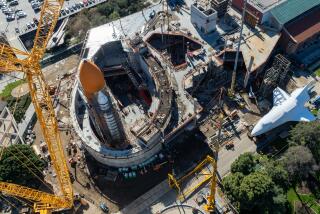Taxpayers to Get Early Look at What Their Money Has Bought
- Share via
It will take about seven months for the Hubble Space Telescope to be calibrated, adjusted and readied for service after it is launched from the space shuttle Discovery this spring. But some taxpayers will be eager to see what their $2 billion has bought, so scientists with the Space Telescope Science Institute in Baltimore plan to focus the pioneering instrument on several well-known targets during its shakedown period.
The images probably will not be quite as sharp as expected when the 12-ton telescope is fully operational, but they will at least offer a glimpse into the future. The first images could come as early as three weeks after the telescope is launched.
Probably the earliest target will be the Andromeda Galaxy, a galaxy much like our own Milky Way and close enough to have bedazzled scientists for the past 100 years. Andromeda is the Milky Way’s “sister galaxy,” and it has given scientists a “mirror” to study their own galaxy. Space Telescope, with its incredibly sharp optics, should give them pictures like they have never seen before.
“We want to move into the core and we’ve never been able to do that before,” said Eric Chaisson, senior scientist at the Space Telescope Science Institute. “We’re going right for the jugular here.”
Chaisson also plans to aim the telescope at a few familiar targets, including the planets Saturn and Jupiter and their respective moons, Titan and Io. With any luck, he said, Space Telescope may be able to catch one of Io’s volcanoes in the act of erupting.
Images of those planets are not expected to be quite as clear as those from the two Voyager spacecraft, but Space Telescope has one advantage over the Voyagers. It can return to the same target again and again to study changes over a long period of time, whereas the Voyagers could only snap images as they passed by and then moved on, never to return.
Other early targets include several galaxies that are peculiar for one reason or another, including M 87, as well as “globular clusters” of stars, including M 15, and a star-forming region of the sky known as Eta Car.
While the early targets will be imaged mainly to satisfy the curious rather than pursue specific scientific goals, scientists around the world, as well as private citizens, will at long last get a good view of what the universe looks like from space.
“There’s a rich program in place,” Chaisson said.
More to Read
Sign up for Essential California
The most important California stories and recommendations in your inbox every morning.
You may occasionally receive promotional content from the Los Angeles Times.













